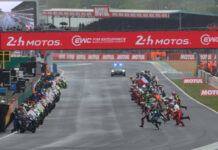IRVINE, Calif. The new lead rules that have banned the sales of many youth all-terrain vehicles and motorcycles could lead to $1 billion in lost economic value annually for the industry, predicts the Motorcycle Industry Council. The projected loss is based on 2008-estimated value of the retail marketplace* for ATVs and off-highway motorcycles and factors out vehicles and related economic value not included as part of the ban. MIC projects that the estimated value of the retail marketplace related to all youth ATVs and off-highway motorcycles exceeds $1.5 billion, but the ban applies only to products that are intended primarily for youth aged 12 and under. Powersports companies have stopped selling affected youth products with lead content in excess of the limits identified in the Consumer Product Safety Improvement Act that went into force February 10. “The potential losses for the powersports industry are massive at a time when this country cannot afford additional economic losses,” said Paul Vitrano, general counsel for MIC and SVIA. “With these vehicles sitting in warehouses instead of on showroom floors, the related sales of most protective gear, accessories, and parts and services are virtually non-existent. Thousands of small businesses across America are impacted by this ban.” Dealers from every corner of the country and other concerned individuals have sent more than 100,000 letters to the U.S. Congress urging support for exclusions from the act for powersports vehicles, parts and accessories. MIC and the Specialty Vehicle Institute of America have spearheaded the massive letter-writing campaign, along with Rep. Tom Self of Missouri, the American Motorcyclist Association, The BlueRibbon Coalition, and Americans for Responsible Recreational Access. Those calling for the exclusions believe that the lead-content provisions of the act, which originally were aimed at toys that can be mouthed by children, were never intended to apply to youth ATVs and motorcycles. Most of the components making up youth powersports products are in compliance. But some parts, that youth would not ingest, unavoidably contain small quantities of lead in excess of the CPSIA limits, such as the valve stems on the tires, aluminum in some brake components, and the terminals on the batteries. MIC’s Web site (www.mic.org) contains background and updated information about this serious issue facing the powersports industry and has links to tools to contact the Consumer Product Safety Commission and Congress to express support for industry’s requests for relief. The Motorcycle Industry Council exists to preserve, protect and promote motorcycling through government relations, communications and media relations, statistics and research, aftermarket programs, development of data communications standards, and activities surrounding technical and regulatory issues. It is a not-for-profit, national trade association representing manufacturers and distributors of motorcycles, scooters, motorcycle/ATV/ROV parts and accessories, and members of allied trades such as publishing companies, advertising agencies, insurance firms and consultants. The MIC is headquartered in Irvine, Calif., with a government relation’s office adjacent to Washington, D.C. First called the MIC in 1970, the organization has been in operation since 1914. * The economic value of the retail marketplace includes retail sales of vehicles (new and used), parts and accessories, dealer servicing, product advertising, vehicle financing charges, insurance premiums, dealer personnel salaries, state sales and dealer personnel income taxes, and vehicle registration fees.
MIC: CPSIA Ban On Youth Powersports Vehicles Could Cost Industry $1 Billion Annually
MIC: CPSIA Ban On Youth Powersports Vehicles Could Cost Industry $1 Billion Annually
© 2009, Roadracing World Publishing, Inc.






